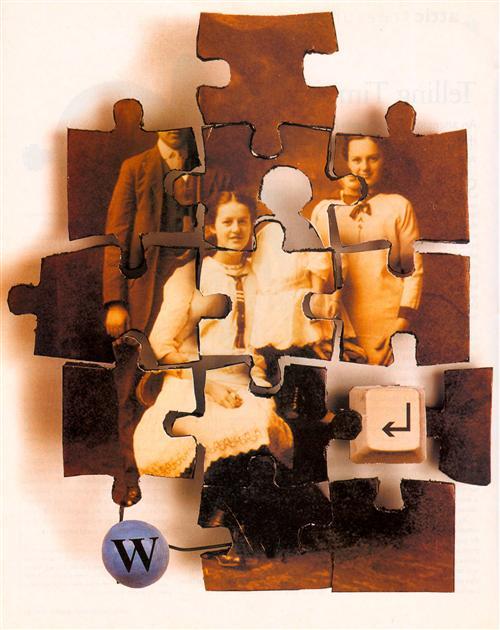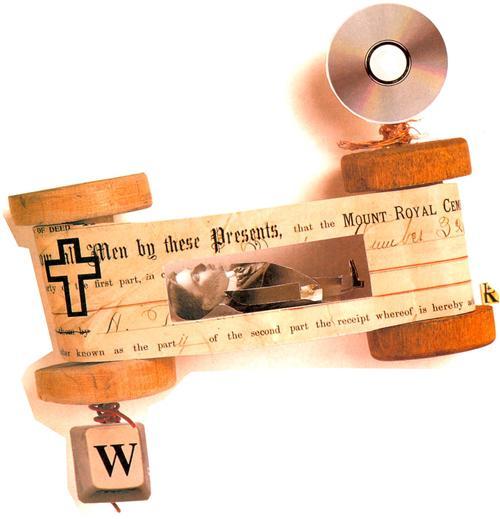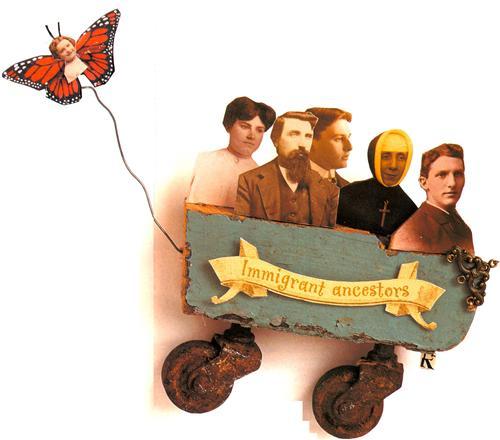Sign up for the Family Tree Newsletter Plus, you’ll receive our 10 Essential Genealogy Research Forms PDF as a special thank you!
Get Your Free Genealogy Forms
"*" indicates required fields
Whether you’re beginning your family history search or have been researching your ancestors for years, you’re creating a unique, personalized family picture. You can choose which ancestors to study and how deeply you want to delve into their lives. Regardless of your ultimate goal, you and your family will appreciate your work if it’s well-done and interesting and you clearly have correct information. How do you make your family history both interesting and accurate? Follow these tips for success as you unpuzzle your past.
1. ORGANIZE EARLY AND OFTEN. There’s no right or wrong way to organize your research notes and record copies, but there are better and worse ways. The worst ways include taking notes in spiral notebooks and storing them on the dining room table. Better ways are numerous, usually involving three-ring binders, file folders or a combination of the two.
Your choice is personal, considering your time, space and budget. The goal is to be able to find quickly any given piece of information. Thus, you need to keep together all information about each person or ancestral couple. Use whatever system works for you, and change your system if you devise a more effective one.
2. BEGIN WITH WHAT YOU KNOW. At the beginning of your family history search, write down names and applicable vital statistics (dates and places of birth, marriage and death) for family members you know best — you, your spouse, your children, your parents and your siblings. If you’re working on a more distant or more elusive ancestor, the process is similar — list in chronological order every fact you’ve collected about the person and build on that foundation.
3. CONCENTRATE FIRST ON THE GENERATIONS CLOSEST TO YOU — yourself and siblings, your parents, your four grandparents and your eight great-grandparents. The goal is to locate the names, dates, places and relationships that identify individuals and form links between generations. Ask family members for pertinent vital statistics; collect information from tombstones and family records.
4. RECORD EXACTLY WHERE YOU GET YOUR INFORMATION. In your notes, write down who told you what and when, or which tombstone, newspaper, book or document furnished data and where that record is located. This documenting process is essential. The goal is for you or someone else to be able to find the same information again. The purpose is to demonstrate that you have collected valid information from the best possible sources and that, to the best of your knowledge, you are claiming the correct ancestors. For more on documenting sources, see The Sleuth Book for Genealogists (Betterway Books).
5. COLLECT INFORMATION ABOUT SIBLINGS IN EACH GENERATION. Knowledge of brothers and sisters is important, especially as you study immigrant ancestors or pre-20th-century generations. Siblings sometimes moved in groups, lived near each other, worshiped together and witnessed legal documents for each other. Studying siblings of an ancestor may help you learn about your ancestor or identify the ancestor’s parents.
6. INTERVIEW RELATIVES AND FAMILY FRIENDS. No amount of library research can duplicate or replace what these people can tell you — in person, by telephone, by mail or by e-mail. Besides collecting names and vital statistics for ancestors and their relatives, you need to gather details of daily life and seek to understand your family’s experience with the historical events happening around them. These details make family history interesting and meaningful.
Ask questions about school, meals, household chores and rules, housing, work, crops and gardens, religious affiliation, holiday customs, reactions to historical events and how historical events affected family members — the Great Depression, a war, a storm. Ask about personalities of family members. View each ancestor as an individual who lived an interesting life that you want to know more about.
7. BE A SKEPTICAL DETECTIVE. Remember that family stories and oral traditions may or may not be factual. Some are “creative remembering” or wishful thinking; some contain grains of truth; some are gems of detail about the character or life of an ancestor.
Consider cautiously any secondhand information from other people, Web sites, electronic databases, family histories, county histories or other compiled materials. If this information doesn’t come with documentation of where the details originated, use it as clues for research; don’t accept it automatically as fact. If information from others does contain documentation, evaluate those sources and check their information yourself.
Whenever you find transcriptions of ancestral records, get a photocopy of the original record. Try to verify details — even original records sometimes contain errors.
8. READ ALL ABOUT IT. Start with a basic book on genealogy, such as Unpuzzling Your Past. Also read books or articles about genealogical research in any state or country where your ancestors lived. States and nations vary in the kinds of records they keep, where they keep them and how you can access them. Knowing about sources in ancestral locales helps you research thoroughly. You can also learn by reading case studies in books such as The Sleuth Book for Genealogists and the journals of genealogy societies, such as the National Genealogical Society Quarterly (available in most major libraries).
9. TAKE ADVANTAGE OF EDUCATIONAL OPPORTUNITIES. Attending genealogy classes, seminars, workshops and meetings of genealogical or historical societies can boost your knowledge so that you can research more effectively. Besides, the personal interaction with other researchers can be very rewarding. Also consider membership in a society in your ancestral locale; it’s often money well-spent. (You can find information on the more than 500 member organizations of the Federation of Genealogical Societies at <www.familyhistory.com/societyhall/>.)
10. CHOOSE ONE OR TWO ANCESTORS AT A 10 TIME FOR CONCENTRATED STUDY. Your other ancestors aren’t going anywhere; they’ll be there for you to research later. Besides, researchers who spread their efforts too thin by trying to work on too many ancestors at once usually don’t tackle and solve the tough questions. By limiting your scope, you can stay organized and focused on the details.
11. WORK BACKWARD IN TIME, ONE GENERATION AT A TIME. The goal in genealogy is to connect each generation to the previous one accurately. If you skip generations trying to reach early, foreign or famous ancestors, you may miss important information or jump to erroneous conclusions. Before researching immigrants in their country of origin, study the ancestors and descendants thoroughly in their adopted country.
12. USE WHAT YOU KNOW ALONG WITH THE HOLES IN YOUR INFORMATION TO PLAN YOUR NEXT STEP. Family history puzzles aren’t handed to us with all the pieces mixed in a box with a completed picture on the front. We have many missing pieces — names, dates, places, relationships and life history. Finding these is the fun and the challenge of genealogy.
Study what you know, identify what’s missing, then decide what you want to find next and where you might find it. Although the goal in each generation is to verify the parents, the first step toward that goal often is finding a birthplace, a maiden name, a marriage record or siblings’ names. These are the building blocks by which you approach your goal.
13. USE ORIGINAL AND CONTEMPORARY RECORDS WHENEVER THEY EXIST. Firsthand accounts and documents closest in time to the events they report are usually the most reliable and desirable. A newspaper obituary for an ancestor may contain names and dates not available in other sources, for example, but the person who prepared the obituary may not have had firsthand information about the ancestor’s birth.
To double-check the birth information, look for a baptism or Bible record, a birth certificate or other record contemporary with the birth. Or try to find a passport, a Social Security application (beginning in 1936), or some other record for which the ancestor furnished his or her birth date.
Millions of original ancestral records exist. You can’t know what interesting tidbits await you in these records until you look.
14. READ ENOUGH RECORDS TO BE CONFIDENT THAT YOU HAVE CORRECT INFORMATION. One original record may be enough to convince you and others that you’ve identified an ancestor’s mother. Your degree of confidence will depend on what the record is and how reliable it may be. Sometimes you need to study many records and put the clues together before you can say with certainty that you have found that mother’s name.
Evaluating documents and data is a skill that improves with experience. And one thing is clear: The more records you read, the more you learn about your ancestor’s life and times.
15. REMEMBER THAT NO BOOK OR WEB SITE CONTAINS ALL YOUR ANCESTORS. Have you ever heard someone brag, “I just found all my mother’s ancestors on the XYZ database”? Such a person is sadly mistaken and misinformed. By their nature, books, Web sites and other compilations cannot be complete.
Besides, it’s impossible to identify all your ancestors. The records that help us build our genealogies rarely extend much earlier than the 16th century. In some ancestral lines, we’re lucky to confirm ancestors alive in 1750.
Don’t worry about how many ancestors you identify or how far back their lives extend. Enjoy the ancestors you find and seek to learn as much about them as you can.
16. REMEMBER THAT HALF YOUR ANCESTORS WERE FEMALE. Have you ever heard the comment, “I don’t have to work on my father’s side of the family; my cousin’s already done it”? Did that cousin include the female ancestors or present only the male line — the continuous surname? In either case, the new genealogist in that family probably still has plenty to do. (For more on finding your female ancestors, see the April 2001 Family Tree Magazine.)
17. STUDY THE ANCESTOR’S CLUSTER OF FRIENDS, RELATIVES AND NEIGHBORS. Not only does this strategy give you a better picture of the ancestor’s life; it also helps you find the harder-to-get pieces of the puzzle — maiden names, parents’ names and places of origin. Think of it as going on a trip: If the road from A to B is washed out, you may have to travel from A to C to D to reach B.
The same is true in genealogy. When you’re trying to identify a female ancestor’s parents, you probably need her maiden name first. To get that piece of the puzzle, you may have to discover her previous residence in order to look for a marriage record. Once you have the maiden name, you may need to study her neighbors or identify her brothers and let their records lead you to her parents. The success that comes from this process is what gets so many genealogists “hooked.”
18. EXPECT YOUR FAMILY NAME TO BE SPELLED VARIOUS WAYS IN PUBLIC DOCUMENTS. Clerks and census takers recorded what they heard or thought they heard. It doesn’t matter what the family called themselves or how they spelled their name. Think creatively as you look in indexes and records. The family name McClelland, for instance, might be spelled McClellan, McLeland or McLellan. Such variations require that you look in different parts of each index you use and think of other ways to spell the name.
Many families tell a story of brothers who moved away and added an e to the end of the surname, while those who remained behind kept spelling the name without the final e. Don’t be fooled: While brothers may have initiated such a change, you will find the same family with the name spelled both ways in the records.
19. BE ALERT FOR ANCESTORS WHO HAVE SURNAMES AS GIVEN NAMES. Is the surname the mother’s or a grandmother’s maiden name? Another relative’s name? Or simply a name the parents liked? Only research can answer these questions. From actual census records, here are some examples that also illustrate the fun in research, since these names make interesting combinations: Ransom Cash, Valentine Power, Hardy Flowers, Eaton Cotton, Green House, Green P. Rice, DeForest Menace.
20. WATCH FOR NAMING PATTERNS. Does the same name appear in several branches or generations of the family? Can you find out why? Recurring given names and middle names sometimes are clues to the names of grandparents, great-grandparents or other relatives.
21. BE AWARE OF COMMON NICKNAMES AND ABBREVIATIONS, since they are often used in records. Nicknames include Molly, Polly, Mamie and Minnie for Mary; Betty, Bess or Betsey (among others) for Elizabeth; Mattie and Patsy for Martha. Common abbreviations include Jno for John and Jonathan, Jas for James, Chas for Charles, and Wm for William.
22. ASK WITHIN THE FAMILY ABOUT ANCESTRAL RECORDS. Ancestral papers within the family vary with the family but can include letters and diaries, scrapbooks and photographs, Bibles and religious certificates, school records and yearbooks, wedding albums and baby books, birth and death certificates, membership and voter registration cards and others. You’ll never know if you don’t ask!
23. USE RECORDS IN FOUR JURISDICTIONS: LOCAL, COUNTY, STATE AND FEDERAL. Local sources include cemeteries, newspapers, schools, business records and city government records, sometimes including vital registrations (birth, death, marriage). In most states, offices in the county courthouses maintain vital records, land and probate records, voter registrations and court records, including some naturalizations of the foreign-born.
State government sources can include state land grants, tax records, legislative petitions, prison and mental hospital records, state censuses and records from colonial, territorial, or Confederate governments. Federal government sources are numerous — especially census, military, immigration, naturalization, federal land and Social Security application records. The National Archives <www.nara.gov/genealogy/> makes available millions of federal records to researchers at its Washington, DC, headquarters, at regional branches, by mail and on microfilm.
24. TAKE ADVANTAGE OF THE MANY PLACES AVAILABLE FOR RESEARCH. Many public and university libraries have materials you’ll find useful, including census records, newspapers, county histories and historical periodicals. Some materials, especially newspapers, are available via interlibrary loan. State archives, state historical societies and large genealogical societies often have impressive collections of research materials. Some state archives also have searchable databases and indexes online.
The largest genealogical library is the Family History Library in Salt Lake City. Its huge collection is available for use by non-members as well as members of the Church of Jesus Christ of Latter-day Saints. Through this library’s worldwide Family History Centers, researchers can rent microfilm and microfiche of millions of ancestral records. You can search the catalog online at <www.familysearch.org/Eng/Library/FHLC/frameset_fhlc.as>; to find the local Family History Center nearest you, consult your local telephone directory under Church of Jesus Christ of Latter-day Saints or see <www.familysearch.org/Eng/Library/FHC/frameset_fhc.asp>
Increasingly, some Web sites have searchable databases of transcribed records, and some original records have been digitized for online use. These sites are constantly changing and enlarging.
25. PRACTICE READING HANDWRITING OF THE PAST. It’s usually easier to read this handwriting than to duplicate it, and experience builds your reading skill. Be aware of quirks such as the old-style double’s that can appear to be fs or p. When you find a word that’s difficult to read, try finding the same word elsewhere in the same handwriting. Get a photocopy if possible. Ask yourself what word would make sense in the context of the sentence or name. More experience with records of the same locale usually helps you identify names. (For more on reading old handwriting, see page 56.)
26. READ ALL KNOWN CENSUS RECORDS FOR YOUR FOCUS ANCESTOR. Created every 10 years since 1790, federal census records help us identify family groups, place ancestors in a given place at a given time, and estimate birth dates and places. Beginning in 1850, the census named free persons in each household and, beginning in 1880, it showed each person’s relationship to the head of household. Census schedules from 1790 to 1920 are now available for research; the 1930 census will be opened in 2002.
You can use the census records on microfilm and, increasingly, on CD-ROM at libraries, Family History Centers or National Archives branches. Some Web sites have census transcriptions, and some have selected digitized images of the originals. To find ancestors in federal census records, you need to know the state where they lived in the census year. Many indexes exist to help you find them in the records. Many states have also made their own enumerations of their population. Censuses are valuable resources for researchers, but use them cautiously, as you would any other record — census takers and families sometimes made mistakes.
27. LOOK FOR ANCESTRAL NAMES IN RECORDS THE ANCESTORS DIDN’T CREATE. In county records, names of witnesses and neighbors can be as important as the names of the people buying and selling land, or the bride and groom. Uncles sometimes named nieces and nephews in their wills. You may find significant information by reading records of your ancestor’s relatives, friends and neighbors. Even identifying an ancestor in a given place at a given time tells you the person was alive and suggests where to look for more records.
28. RECORD ALL INFORMATION GIVEN IN A DOCUMENT. When you find an ancestor mentioned in a document, copy all the information or photocopy the whole document. As your search progresses, you may need more details from the document.
29. ENJOY UNPUZZLING YOUR FAMILY! It’s a fascinating experience.
ADVERTISEMENT




